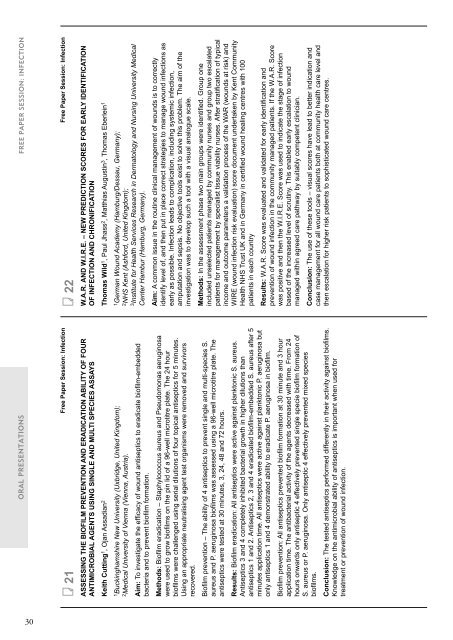Create successful ePaper yourself
Turn your PDF publications into a flip-book with our unique Google optimized e-Paper software.
ORAL PRESENTATIONS<br />
21<br />
Free Paper Session: Infection<br />
ASSESSING THE BIOFILM PREVENTION AND ERADICATION ABILITY OF FOUR<br />
ANTIMICROBIAL AGENTS USING SINGLE AND MULTI SPECIES ASSAYS<br />
Keith Cutting 1 , Ojan Assadian 2<br />
1 Buckinghamshire New University (Uxbridge, United Kingdom);<br />
2 Medical University of Vienna (Vienna, Austria).<br />
Aim: To investigate the efficacy of wound antiseptics to eradicate biofilm-embedded<br />
bacteria and to prevent biofilm formation.<br />
Methods: Biofilm eradication – Staphylococcus aureus and Pseudomonas aeruginosa<br />
were used to grow biofilms on the pin lid of a 96-well microtitre plate. The 24 hour<br />
biofilms were challenged using serial dilutions of four topical antiseptics for 5 minutes.<br />
Using an appropriate neutralising agent test organisms were removed and survivors<br />
recovered.<br />
Biofilm prevention – The ability of 4 antiseptics to prevent single and multi-species S.<br />
aureus and P. aeruginosa biofilms was assessed using a 96-well microtitre plate. The<br />
antiseptics were tested at 30 minutes, 3, 24, 48 and 72 hours.<br />
Results: Biofilm eradication: All antiseptics were active against planktonic S. aureus.<br />
Antiseptics 3 and 4 completely inhibited bacterial growth in higher dilutions than<br />
antiseptics 1 and 2. Antiseptics 2, 3 and 4 eradicated biofilm-embedded S. aureus after 5<br />
minutes application time. All antiseptics were active against planktonic P. aeruginosa but<br />
only antiseptics 1 and 4 demonstrated ability to eradicate P. aeruginosa in biofilm.<br />
Biofilm prevention: All antiseptics prevented biofilm formation at 30 minute and 3 hour<br />
application time. The antibacterial activity of the agents decreased with time. From 24<br />
hours onwards only antiseptic 4 effectively prevented single specie biofilm formation of<br />
S. aureus or P. aeruginosa. Only antiseptic 4 effectively prevented mixed species<br />
biofilms.<br />
Conclusion: The tested antiseptics performed differently in their activity against biofilms.<br />
Knowledge on the antimicrobial ability of antiseptics is important when used for<br />
treatment or prevention of wound infection.<br />
FREE PAPER SESSION: INFECTION<br />
22<br />
Free Paper Session: Infection<br />
W.A.R. and W.I.R.E. – NEW PREDICTION SCORES FOR EARLY IDENTIFICATION<br />
OF INFECTION AND CHRONIFICATION<br />
Thomas Wild 1 , Paul Jhass 2 , Matthias Augustin 3 , Thomas Eberlein 1<br />
1 German Wound Academy (Hamburg/Dessau, Germany);<br />
2 NHS Kent (Ashford, United Kingdom);<br />
3 Institute for Health Services Research in Dermatology and Nursing University Medical<br />
Center Hambur (Hamburg, Germany).<br />
Aim: A common issue in the routine clinical management of wounds is to correctly<br />
identify level of, and then put in place correct strategies to manage wound infections as<br />
early as possible. Infection leads to complication, including systemic infection,<br />
amputation and sepsis. No objective tools exist to solve this problem. The aim of the<br />
investigation was to develop such a tool with a visual analogue scale.<br />
Methods: In the assessment phase two main groups were identified. Group one<br />
included unselected patients managed by community nurses and group two escalated<br />
patients for management by specialist tissue viability nurses. After stratification of typical<br />
income and outcome parameters a validation process of the WAR (wounds at risk) and<br />
WIRE (wound infection risk evaluation) score document undertaken by Kent Community<br />
Health NHS Trust UK and in Germany in certified wound healing centres with 100<br />
patients in each country<br />
Results: W.A.R. Score was evaluated and validated for early identification and<br />
prevention of wound infection in the community managed patients. If the W.A.R. Score<br />
was positive and then the W.I.R.E. Score was used to indicate the stage of infection<br />
based of the increased level of scrutiny. This enabled early escalation to wound<br />
managed within agreed care pathway by suitably competent clinician.<br />
Conclusion: The use of these tools – visual scores have lead to better indication and<br />
case management for all wound care patients both at community health care level and<br />
then escalation for higher risk patients to sophisticated wound care centres.<br />
30






